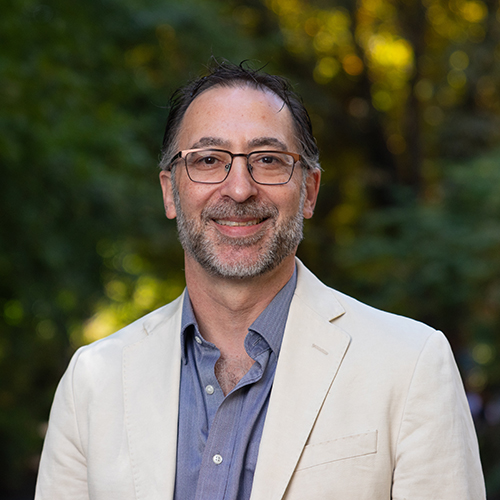Werner Herzog, one of Germany’s most renowned and prolific filmmakers, is a vocal critic of documentary cinema. Yet nearly half of his 60 films can be categorized as documentaries. That love/hate relationship is the focus of Ferocious Reality, a new book by Eric Ames, UW associate professor of http://germanics.washington.edu/Germanics and a member of the cinema studies faculty.
Ames was inspired to explore the topic after viewing Grizzly Man, Herzog’s documentary about an American’s fatal obsession with grizzly bears in Alaska. The film uses new and found footage, interviews, and Herzog’s narration to tell the disturbing tale of a man who blurs the boundaries between human and animal, with tragic consequences. The film received numerous accolades, including awards from the Directors Guild of America and the National Society of Film Critics.

“I first saw Grizzly Man at the 2005 Seattle International Film Festival,” recalls Ames. “I was just riveted and knew I had to write about it. I’d seen a dozen Herzog films already, but Grizzly Man sent me to look at his documentaries. I discovered that surprisingly little had been written about them, and yet the documentaries are arguably his best films—period. I realized then there was a book to be written.”
Ames was particularly intrigued by Herzog’s blatant rejection of the genre. “He’s made it known publicly that he hates documentaries,” Ames explains. “What I learned is that he’s not outside the tradition at all. He’s dismissing documentaries in order to engage with them on his own terms.”
Herzog’s specific beef is with cinéma vérité—the idea of cinematic truth that is often attached to documentaries, particularly those claiming to merely observe the world. He prefers the term “ecstatic truth” to describe his films, arguing that they present his own truth rather than an unbiased truth. He argues that he doesn’t simply record what he sees, but interjects himself and his viewpoint into the film.
Ames acknowledges that distinction but also complicates it. “Everyone knows that documentaries are invented, stylized, framed by the filmmaker,” says Ames. “There are always choices to be made, beginning with where to place the camera. Herzog just emphasizes the role of stylization instead of trying to hide it.”
Herzog literally announces his presence in his films by serving as narrator. Speaking with a heavy German accent, he has narrated every one of his documentaries since 1973. “That has been a deliberate decision,” says Ames. “He’s talked about the importance of ensuring that his presence is felt.” This approach, once novel, is now more common. Recent filmmakers—from Michael Moore to Morgan Spurlock—have taken the idea in other directions by frequently placing themselves front and center in their “documentary” films.
Ames viewed all of Herzog’s documentaries multiple times (see the end of this article for a few of Ames’s favorites) and studied the documentary film genre more generally for his book. He also researched the subjects of Herzog’s films, from religion to 17th century music. “It’s been fun,” says Ames. “Throughout the process, I got to learn about a lot of interesting material and then think about what Herzog has done with it.”
Herzog’s latest documentary, Cave of Forgotten Dreams, perhaps the most-celebrated documentary of 2010, reached the filmmaker’s widest audience yet. The film shows the remarkably preserved prehistoric paintings in the recently discovered Chauvet cave in France, which was immediately and permanently closed to the public. Using 3D technology, Herzog offers viewers a chance to experience the cave paintings along with him and his crew. The film, sponsored by the French Minister of Culture, is stunning and thought-provoking—yet clearly within the documentary tradition.
“Werner Herzog used to be a rebel in the documentary world,” says Ames. “But documentary culture has caught up with him and embraced him, even though he wants nothing to do with it. He has said that he hopes to be the grave digger of cinéma vérité. But in the end, what he’s done is made an extraordinary career for himself within the field of his own resistance. In so doing he has also paved the way for a new documentary cinema.”
Want to check out some of Werner Herzog’s most intriguing documentaries? Eric Ames offers his top picks:
Grizzly Man (2005), for its creative and evocative use of found footage.
Land of Silence and Darkness (1971), because it explores the tactile properties of the film medium.
The Great Ecstasy of Woodcarver Steiner (1973), because it turns the extreme sport of ski-flying into a ritual drama of martyrdom.
Lessons of Darkness (1992), for its se aring landscapes, and how they render a vision of hell.
Little Dieter Needs to Fly (1997), because the main character, a former POW, is both exemplary and unlike anyone you'll ever meet.
More Stories

Need a break from holiday movies? Try these
For those wanting a break from holiday movies, Cinema & Media Studies faculty and grad students offer suggestions.

The Public Impact of Private Cities
Geography major Edwin Bai has researched private cities, developed by individuals and corporations, that "take the libertarian idea of low government regulation to the maximum."

The Curious Journey of Chinese Characters
Several Asian countries adapted the Chinese writing system—the oldest writing system still in use—for their own languages. In a new book, Professor Zev Handel shares how that happened.